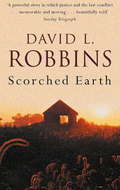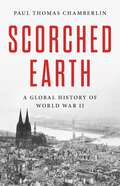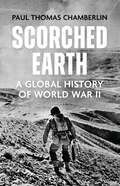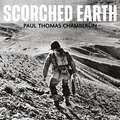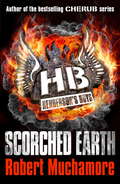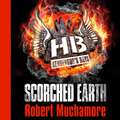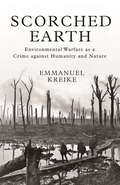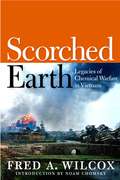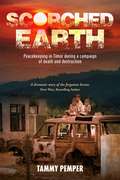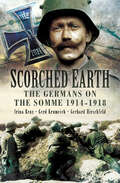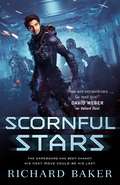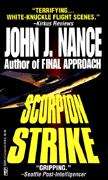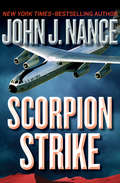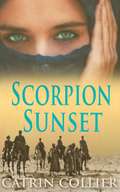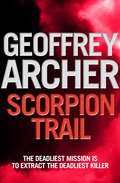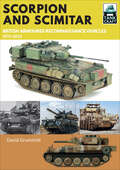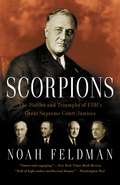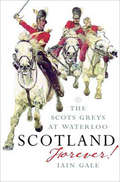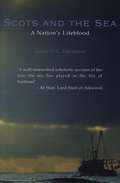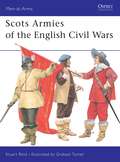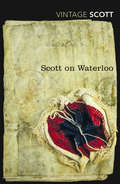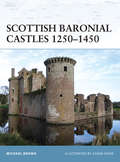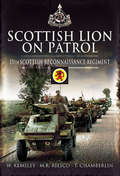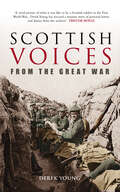- Table View
- List View
Scorched Earth
by David L. RobbinsFrom the bestselling author of WAR OF THE RATS comes a novel of searing intensity and uncompromising vision . . .The inhabitants of Good Hope, Virginia, haven't felt the cooling effects of rain in weeks. With the town a tinderbox waiting to explode, all it will take is a spark to ignite the rage and hatred so carefully hidden. And then a tragedy occurs. A baby is born and dies in her mother's arms. The child, Nora Carol, is buried quickly and quietly the next day in the churchyard. It should have ended there, but it didn't, for Nora Carol is of mixed race. The white deacons of Good Hope's Victory Baptist Church, trying to protect the centuries-old traditions of their cemetery, have the body exhumed. That night the church is set ablaze, and the sole witness is the only suspect - Elijah, Nora Carol's father. What follows is a legal case that reveals a host of hidden prejudices, incendiary secrets, and ultimately, an act of justice that has nothing to do with the law . . .
Scorched Earth: A Global History of World War II
by Paul Thomas ChamberlinAn unsparing, "sweeping," and "vivid" (Drew Gilpin Faust, author of This Republic of Suffering) new history of World War II, recasting the conflict as a brutal struggle for survival among declining and ascendant imperial powers In popular memory, the Second World War was an unalloyed victory for freedom over totalitarianism, marking the demise of the age of empires and the triumph of an American-led democratic order. In Scorched Earth, historian Paul Thomas Chamberlin dispatches the myth of World War II as a good war. Instead, he depicts the conflict as it truly was: a massive battle beset by vicious racial atrocities, fought between rival empires across huge stretches of Asia and Europe. The war was sparked by German and Japanese invasions that threatened the old powers&’ dominance, not by Allied opposition to fascism. The Allies achieved victory not through pluck and democratic idealism but through savage firebombing raids on civilian targets and the slaughter of millions of Soviet soldiers. The Soviet Union and the United States emerged as hyper-militarized new imperial powers, each laying claim to former Axis holdings across the globe before turning on one another and triggering a new forever war. Dramatically rendered and persuasively argued, Scorched Earth shows that World War II marked the culmination of centuries of colonial violence and ushered in a new era of imperial struggle.
Scorched Earth: A Global History of World War II
by Paul Thomas ChamberlinA radical new history of history's most brutal struggle for survival between imperial powers. In popular memory, World War II was an unalloyed victory for freedom over totalitarianism, and democratic order over the age of empires. Scorched Earth dispatches the myth of World War II as a 'good' war. Instead, it reveals the conflict as a massive battle beset by vicious racial atrocities, fought between rival empires across huge stretches of Asia and Europe. The war was sparked by German and Japanese invasions that threatened the old powers' dominance, not by Allied opposition to fascism. The Allies achieved victory not through pluck and democratic idealism but through savage firebombing raids on civilian targets and the slaughter of millions of Soviet soldiers. The Soviet Union and the United States emerged as hyper-militarized new imperial powers, each laying claim to former Axis holdings across the globe before turning on one another and triggering a new forever war. Dramatically rendered and persuasively argued, Scorched Earth shows that World War II marked the culmination of centuries of colonial violence and ushered in a new era of imperial struggle.
Scorched Earth: A Global History of World War II
by Paul Thomas ChamberlinA radical new history of history's most brutal struggle for survival between imperial powers. In popular memory, World War II was an unalloyed victory for freedom over totalitarianism, and democratic order over the age of empires. Scorched Earth dispatches the myth of World War II as a 'good' war. Instead, it reveals the conflict as a massive battle beset by vicious racial atrocities, fought between rival empires across huge stretches of Asia and Europe. The war was sparked by German and Japanese invasions that threatened the old powers' dominance, not by Allied opposition to fascism. The Allies achieved victory not through pluck and democratic idealism but through savage firebombing raids on civilian targets and the slaughter of millions of Soviet soldiers. The Soviet Union and the United States emerged as hyper-militarized new imperial powers, each laying claim to former Axis holdings across the globe before turning on one another and triggering a new forever war. Dramatically rendered and persuasively argued, Scorched Earth shows that World War II marked the culmination of centuries of colonial violence and ushered in a new era of imperial struggle.
Scorched Earth: Book 7 (Henderson's Boys #7)
by Robert MuchamoreSummer, 1944.As Allied soldiers prepare to land in France, Marc and his friends must destroy a battalion of German tanks that could halt the invasion in its tracks.The tide of war has turned against the Nazis, but desperation has made them more brutal than ever.Henderson's Boys' final mission will be their most dangerous. With food and weapons in short supply, survival is the biggest challenge of all.
Scorched Earth: Book 7 (Henderson's Boys #7)
by Robert MuchamoreSummer, 1944.As Allied soldiers prepare to land in France, Marc and his friends must destroy a battalion of German tanks that could halt the invasion in its tracks.The tide of war has turned against the Nazis, but desperation has made them more brutal than ever.Henderson's Boys' final mission will be their most dangerous. With food and weapons in short supply, survival is the biggest challenge of all.(P) Hodder Children's Books 2015
Scorched Earth: Environmental Warfare as a Crime against Humanity and Nature (Human Rights and Crimes against Humanity #38)
by Emmanuel KreikeA global history of environmental warfare and the case for why it should be a crimeThe environmental infrastructure that sustains human societies has been a target and instrument of war for centuries, resulting in famine and disease, displaced populations, and the devastation of people’s livelihoods and ways of life. Scorched Earth traces the history of scorched earth, military inundations, and armies living off the land from the sixteenth to the twentieth century, arguing that the resulting deliberate destruction of the environment—"environcide"—constitutes total war and is a crime against humanity and nature.In this sweeping global history, Emmanuel Kreike shows how religious war in Europe transformed Holland into a desolate swamp where hunger and the black death ruled. He describes how Spanish conquistadores exploited the irrigation works and expansive agricultural terraces of the Aztecs and Incas, triggering a humanitarian crisis of catastrophic proportions. Kreike demonstrates how environmental warfare has continued unabated into the modern era. His panoramic narrative takes readers from the Thirty Years' War to the wars of France's Sun King, and from the Dutch colonial wars in North America and Indonesia to the early twentieth century colonial conquest of southwestern Africa.Shedding light on the premodern origins and the lasting consequences of total war, Scorched Earth explains why ecocide and genocide are not separate phenomena, and why international law must recognize environmental warfare as a violation of human rights.
Scorched Earth: Legacies of Chemical Warfare in Vietnam
by Noam Chomsky Fred A. WilcoxScorched Earth is the first book to chronicle the effects of chemical warfare on the Vietnamese people and their environment, where, even today, more than 3 million people--including 500,000 children--are sick and dying from birth defects, cancer, and other illnesses that can be directly traced to Agent Orange/dioxin exposure. Weaving first-person accounts with original research, Vietnam War scholar Fred A. Wilcox examines long-term consequences for future generations, laying bare the ongoing monumental tragedy in Vietnam, and calls for the United States government to finally admit its role in chemical warfare in Vietnam. Wilcox also warns readers that unless we stop poisoning our air, food, and water supplies, the cancer epidemic in the United States and other countries will only worsen, and he urgently demands the chemical manufacturers of Agent Orange to compensate the victims of their greed and to stop using the Earth's rivers, lakes, and oceans as toxic waste dumps. Vietnam has chosen August 10--the day that the US began spraying Agent Orange on Vietnam--as Agent Orange Day, to commemorate all its citizens who were affected by the deadly chemical. Scorched Earth will be released upon the third anniversary of this day, in honor of all those whose families have suffered, and continue to suffer, from this tragedy.
Scorched Earth: Peacekeeping in Timor during a campaign of death and destruction
by Tammy PemperAs a UN peacekeeper, I joined the East Timorese fight for life. By then, the earth had drunk the blood of one third of their population. But worse was still to come. I would see it for myself. I saw bodies carried to their deaths, machetes carve flesh from bone, and bullets spray into crowds of Timorese and at us peacekeepers. I learned the true meaning of fear, hopelessness, and courage. Shades of truth were twisted for evil gain. Every day I prepared to die. Decisions I made, which seemed so right, jeopardized the lives of others. Police held automatic weapons to my head, militia wrote my name on death lists, and people drew their last breath, all of them brave, braver than me. For this is the true story of my experience. In the midst of the East Timorese fight for independence, militia were determined to enact their scorched earth policy and raze Timor to the ground. Timorese voted; Timor burned. It is their story, our story: a story that must be told.
Scorched Earth: The Germans on the Somme, 1914–18
by Gerhard Hirschfeld Gerd Krumeich Irina RenzThis book discusses in detail the experience of German warfare in the first World War, focusing specifically on the battle of the Somme. The Somme, together with other regions of northern France, had also lain under German domination. Its inhabitants had been rigorously suppressed and their possessions carted off as booty. Finally, during their 1917 withdrawal, the Germans had subjected the whole region to Operation Alberich, a retreat involving unparalleled brutality which left the population in occupation of a wilderness wrought by war (the "scorched earth policy"). A well-known, and well-researched account, the authors have combined their research skills to produce a book which includes private testimonies. Amongst these are many unknown or previously unpublished letters and diaries as well as numerous photographs.
Scornful Stars (Breaker of Empires #3)
by Richard BakerRichard Baker continues his new military science fiction series, Breaker of Empires, with vivid space battles and elements of politics and cultural heritage, picking up where Valiant Dust and Restless Lightning have led.Now a captain, Sikander Singh North commands the destroyer Decisive, assigned to Zerzura, a haven for piracy and the next playing-board in the Great Game. The Aquilan Commonwealth and the Empire of Dremark vie for the allegiance of local ruler Marid Pasha, a competition with stakes that reach far beyond the sector's pirate-infested limits. Sikander must stop the pirate attacks while charting his course between the ambitions of Marid Pasha, a dubious alliance with a shipping magnate, and the inexperience of Decisive’s crew...a situation that only grows more complicated when an old enemy returns.Breaker of EmpiresValiant DustRestless LightningScornful StarsAt the Publisher's request, this title is being sold without Digital Rights Management Software (DRM) applied.
Scorpion Strike
by John J. NanceTHE GULF WAR IS OVER. BUT A DEADLIER WAR IS ABOUT TO ERUPT.... In the wake of Operation Desert Storm, a defecting Iraqi scientist has revealed Saddam Hussein's horrifying plans for a devastating counterstrike against his enemies... and the world. With no time to spare, American forces must remobilize to locate and neutralize the underground laboratory where a lethal super-virus is ready to be unleashed. But an eleventh-hour disaster thrusts the entire mission into the hands of Air Force comrades-in-arms Colonel Will Westerman and Reserve Colonel-turned-commercial pilot Doug Harris. Flying into the heart of Iraqi power, they must depend on their skills-and each other-as never before, to complete a mission that looks more and more like a suicide run....
Scorpion Strike
by John J. NanceTwo air force pilots race to stop an Iraqi bioweapon in this thriller filled with &“white-knuckle flight scenes&” from a New York Times–bestselling author (Kirkus Reviews). A scientist charged by Saddam Hussein with pioneering a horrific breakthrough in biological warfare, Shakir Abbas defects at the American embassy to warn the world of the new weapon. America&’s worst nightmare has come true—and now US forces must scramble to put together a plan to destroy the weapon of mass destruction. When the operation goes awry in Saudi Arabia, Col. Will Westerman commandeers a C-141 transport to get the Special Forces team into Iraq. With the help of air force buddy Col. Doug Harris, Westerman reaches his target only to discover that the unthinkable has happened. Now they must use all their ingenuity, daring, and adrenaline to stop a worldwide catastrophe—and survive what looks increasingly like a suicide mission. From the bestselling author of Pandora&’s Clock and the Kat Bronsky series—a pilot and Operation Desert Storm veteran himself—this is a &“gripping&” aviation thriller (Seattle Post-Intelligencer) featuring &“thoroughly realistic background detail and an entirely too plausible plot&” (Kirkus Reviews).
Scorpion Sunset
by Catrin CollierVictoria and Andrew Pringle are now happily married and working hard to make a success of Langmune Farm but in 1939 war is declared casting a long shadow over the people and the peaceful glens. Libby shares her parents love of the land and Billy Lennox, the laird's illegitimate grandson, becomes a close friend when they cycle to school together. Then tragedy strikes and Billy is made to feel responsible. He is filled with doubts and dark moods and moves to Yorkshire to get away. But can he ever be happy away from the glens and friends of his childhood?
Scorpion Trail: A deadly mission to hunt a deadly killer…
by Geoffrey Archer_______________________________________Alex Crawford has been out of MI5 and the combat zone for twenty years, but now fate has thrust him back into the front line.Though he is an aid worker, the secret service minders who have protected him for so long have reactivated him: they want information about the man who perpetrated a massacre in a Muslim village in Bosnia at the height of the Kosovo War.His target is the most ruthless killer in the whole war zone: Milan Pravic, codename the Scorpion. And the only eyewitness to the massacre is a twelve-year-old girl whom Pravic will do anything to silence.
Scorpion and Scimitar: British Armoured Reconnaissance Vehicles, 1970–2022 (TankCraft #33)
by David GrummittThe British Scorpion and Scimitar are among the most successful armored reconnaissance vehicles ever built and, almost fifty years after the initial design was introduced, updated versions are still in service today. These compact, maneuverable and fast-moving light tanks played a significant peace-keeping role in conflict zones around the world and went into action during wars in the Falklands, the Gulf and Iraq. They are also a popular subject with tank modelers and enthusiasts which is why David Grummitt’s expert history and guide is such a valuable source of reference. As well as describing in detail their technical development and operational history, he gives a full account of the wide range of modeling kits and accessories available in all the popular scales. Included is a modeling gallery which features six builds covering a range of Scorpions and Scimitars serving with different nations and a section of large-scale color profiles which provide both information and inspiration for modelers and military enthusiasts alike.
Scorpion in the Sea: The Goldsborough Incident
by P. T. DeutermannMike Montgomery has a reputation as a troublemaker with the Navy brass. And he's stuck with a politically sensitive assignment to create a story for the media on some suspicious off-shore incidents. Now he's about to add to his problems by starting an affair with another officer's wife. Scorpion in the Sea sets a fast pace in a new world order without the old rules and signposts.
Scorpions: The Battles and Triumphs of FDR's Great Supreme Court Justices
by Noah FeldmanA tiny, ebullient Jew who started as America's leading liberal and ended as its most famous judicial conservative. A Klansman who became an absolutist advocate of free speech and civil rights. A backcountry lawyer who started off trying cases about cows and went on to conduct the most important international trial ever. A self-invented, tall-tale Westerner who narrowly missed the presidency but expanded individual freedom beyond what anyone before had dreamed. Four more different men could hardly be imagined. Yet they had certain things in common. Each was a self-made man who came from humble beginnings on the edge of poverty. Each had driving ambition and a will to succeed. Each was, in his own way, a genius. They began as close allies and friends of FDR, but the quest to shape a new Constitution led them to competition and sometimes outright warfare. SCORPIONS tells the story of these four great justices: their relationship with Roosevelt, with each other, and with the turbulent world of the Great Depression, World War II, and the Cold War. It also serves as a history of the modern Constitution itself.
Scotland Forever: The Scots Greys at Waterloo
by Iain GaleA colorful account of the part played by the Royal Scots Dragoon Guards in the Battle of Waterloo—and their contribution to victory over Napoleon. One of the most iconic incidents of the Battle of Waterloo in 1815 was the charge of the Scots Greys, a crack cavalry regiment, into the heart of the French army. It was a moment of supreme daring and horse-riding skill, and Sergeant Ewart of the Greys succeeded in snatching one of Napoleon&’s coveted eagle standards. However, it was also a military blunder. The Greys were quickly surrounded by enemy cavalry and cut to pieces. Of the regiment&’s 442 officers and men almost half, 198, were killed or injured. In the end the battle was won by the British and their allies and the eagle of the French 45th regiment is now on show in Edinburgh Castle. Iain Gale brings the bare outline of this legendary military exploit to life, giving the stories of the men involved and reconstructing the prelude, the aftermath, life in the Greys and the Battle of Waterloo as a whole. It is a uniquely exciting story of courage and military tactics in the heat of war.&“The reader is thrown headfirst into the chaos of the battle, truly evoking the great sense of the terror endured by the brave cavalry.&” —Scottish Field
Scots And The Sea: A Nation's Lifeblood
by James DavidsonWith over six thousand miles of rugged coastline, nowhere in Scotland is more than forty-five miles from tidal waters, and seven of the biggest towns and cities are seaports. No wonder then that the sea has shaped Scotland, and in turn the Scots have helped to shape maritime history, trade and communications.Scots and the Sea is a unique and compelling account of a small, sparsely populated country's relationship with the most powerful force on earth. It is a celebration of the courage and endurance of fishermen and their families, the selfless bravery of lifeboat volunteers and the individual brilliance of leaders like Admiral Cochrane, who helped establish free nations across the globe. The illicit activities of scoundrels like Captain Kidd also provide a taste of the darker side of the story. Scotland's proud maritime tradition is traced through this volume, which examines the development of trade, the founding of a Scottish merchant navy and the pressures towards Union with England. It explores ports, harbours and shipyards, and outlines the vital role Scotland has played in shipbuilding and marine engineering - from the galleys and longships of early history to clippers, steamships, ocean liners, hovercraft and oil rigs. Also recounted are the exploits and achievements of Scots in all these fields, including those of James Watt, William Symington, Henry Bell and Robert Stevenson. Finally, it takes a look into the future, where Scottish research into wave and tidal power could become vital in providing a source of sustainable energy. Over the years, many Scots have made their living and their fortune from the sea, others have lost their lives to it – Scots and the Sea is a tribute to all of them.
Scots Armies of the English Civil Wars
by Stuart Reid Graham TurnerIn the summer of 1642 the First Civil War between king and parliament had broken out in England. Initially both sides were confident of victory, but after the first campaigns ended in stalemate they began looking for allies. The meddling of the Stuart Kings with Scotland's religious traditions provoked the National Covenant, and later the Solemn League and Covenant. Yet many Scots continued to support the King, and after his execution, his exiled son.This fine text by Stuart Reid examines the Scots armies who fought in the English Civil Wars (1642-1651), and features numerous illustrations and photographs, including full page colour plates by Graham Turner.
Scott on Waterloo
by Sir Walter ScottOn the 200th anniversary of the Battle of Waterloo discover a fascinating primary source: Walter Scott's accounts of his journey to the battlefieldIn the immediate aftermath of the Battle of Waterloo tourists flocked from Britain to witness the scene of the most important conflict of their generation. Walter Scott was among them, and with a commission from his publisher for a travel book and a long poem. These prose and verse accounts bring to vivid life the carnage, spectacle and excitement of a fascinating period of European history. Brilliantly introduced and annotated by Paul O'Keeffe, this edition elucidates and contextualises Scott's first-hand account of his travels, his dashing epic, ‘The Field of Waterloo’ and the eerily chilling 'Dance of Death'.
Scottish Baronial Castles 1250-1450
by Michael Brown Adam HookDevastated by the civil wars of the 17th century or by the neglect and deliberate destruction of their owners who saw them as archaic and barbaric, the vast majority of Scottish baronial castles built between 1250 and 1450 survive as little more than skeletal ruins. These reminders of Scotland's past have captured the imaginations of romantics, artists, writers and tourists since the late 18th century. Often set in spectacular surroundings, on cliff-tops, islands, and gorges, their ruined grandeur evokes a medieval world of sieges, banquets and murders, and provides a rare physical link with the Anglo-Scottish wars of Robert the Bruce and William Wallace. This book examines the three periods of castle building in the years 1250-1450: the years of peace in the late 13th century; the six decades of war with the English when the castles became key centers for garrisons and government; and the post-war era of castle building and reconstruction. Covering castles in the Isles, the Lowlands and the Highlands, and featuring some of the most striking examples of the art, such as Caelaverock and Bothwell this book presents the story of these monuments in an accessible and highly-illustrated format.
Scottish Lion on Patrol: 15th Scottish Reconnaissance Regiment
by T. Chamberlin M.R. Riesco W. KemsleyScottish Lion on Patrol was first published in 1950, the record of the 15th Scottish Reconnaissance Regiments formation, training and service in the campaign that took them from Normandy to the Baltic. They played a key role in the liberation of Europe and the Regiment was unique in that it was in the forefront of the crossings of the Rivers Seine, Rhine and Elbe. The troops who landed in Normandy were highly trained but most of them had not experienced actual combat; however they very quickly learned the skills necessary to survive and defeat a cunning and resourceful foe. Full of eye-witness accounts, this is a true story of a real Band of Brothers, the original work being faithfully reproduced and significant new material from personal recollections which are graphic, moving and occasionally humorous.
Scottish Voices From the Great War
by Derek YoungScotland's response to the Great War has, up until now, largely been marginalized or ignored. With a proportionally higher number of volunteers than any other home nation, Scotland's youth played a significant part in Britain's war effort. Here is the first study of Scotland's response to the call to arms; the true story behind the raising, the training, life in the trenches and the sacrifices faced by those battalions raised in Scotland. This book focuses on the experiences of those who served in the Scottish divisions. Charting the course of emotions from initial enthusiasm in August 1914 through to outright disillusionment with the continuation of the war in 1917, the author clearly shows how life at the front line produced both physical and emotional changes in those caught up in the horrors of trench warfare.
